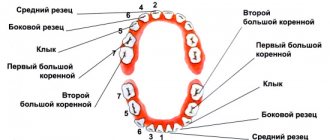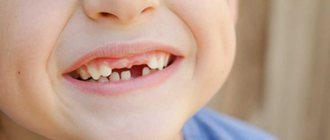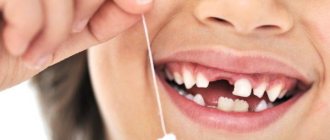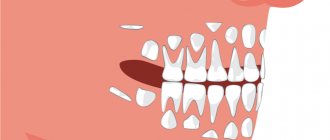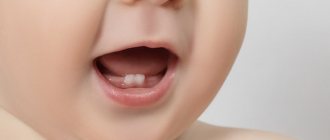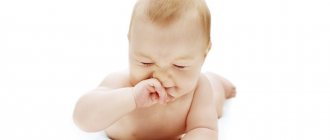Mom and dad can't wait for their child's baby teeth to begin to be replaced by molars. Such changes always raise a lot of questions. Usually molars grow without difficulty, but there is always a risk of complications. You can avoid possible unpleasant consequences if you regularly visit the pediatric dentist. The dental clinics of the Stomus network employ experienced and qualified specialists who can identify teething difficulties and help cope with them.
Content:
- Formation of permanent bite:
- Eruption of permanent teeth in children: timing and features:
- Features of care.
1.1. How does eruption occur?
2.1. Approximate timing of bite change. 2.2. Associated symptoms.
Until recently, dentists, like pediatricians, were quite strict about the time frame for the eruption of molars in children. In accordance with generally accepted standards, this process begins at 6 years and ends by 12–13 years. But as clinical data accumulates, experts are increasingly inclined to believe that such terms are quite arbitrary, that is, they are observed in most children, and deviations from the norm are not always a sign of a disease or some kind of developmental disorder.
When does a child's molars come out?
Growing permanent teeth is a big job for the body, which we rarely notice. Changes begin at 3 years - the rudiments of molars are formed. At age 5, noticeable gaps appear between the baby teeth to make room for new “tenants.”
Which teeth come out first is determined by a lottery - genetics. In half of the cases, growth begins with “sixes”. Molars grow by the age of 7-8 years, at the same time the front incisors change.
Teeth grow slowly but painlessly. At 14, the main bite is already formed. “Late” wisdom teeth - third molars grow in a few years, at 18-21 in most adults.
Formation of permanent bite
The development of molars in children begins in the prenatal period and lasts until 18–20 years, when their structure fully corresponds to “adult” parameters. That is why their condition, as well as the exact timing of eruption, depend on many factors. This:
- genetic predisposition, which is associated with metabolic characteristics;
- insufficient consumption of mineral elements in food, and we are talking about the nutrition of not only the child, but also the woman during pregnancy;
- fluoride deficiency in water and food;
- compliance with hygiene rules;
- some infectious diseases suffered by the mother (during gestation);
- insufficient functional activity of the salivary glands, since saliva contains certain substances that additionally provide mineralization of enamel, etc.
How does teething occur?
With the exception of rare cases of congenital or acquired pathologies, the appearance of molars coincides with the time of loss of milk teeth. Usually, part of the permanent tooth is already visible in this place; sometimes its growth is delayed for a short time, which is also one of the normal options.
Contrary to popular belief, temporary teeth have roots, and they differ in shape and structure from permanent ones: they can be curved and “sit” quite deeply in the gums. But as the child grows up and the rudiments of the molars grow, the “temporary” roots gradually dissolve and on an x-ray they look “eaten away”, shortened.
In this case, the pulp, where the nerve endings and blood vessels are concentrated, is replaced by granular tissue, which also participates in the resorption of the “milky” root system. And if depulpation (nerve removal) was previously performed due to injury or advanced caries, this process occurs faster.
How to help your baby?
To alleviate the symptoms accompanying teething in a child, parents can use one of the following methods:
- Let your baby chew on a crust of bread . Such manipulations will provide gum massage. However, you need to carefully monitor your child so that he does not choke on the spicy crumbs.
- Wipe off saliva from your baby's skin every half hour . Excessive salivation irritates the skin and can lead to rashes, dry skin and allergic reactions.
- Massage your baby's gums . If your baby is suffering from pain and inflammation of the gums, try gently massaging the gums with a clean finger. But, before you start the massage, remember not to lubricate fragile baby gums with alcohol or apply tablets to the tissues.
Eruption of permanent teeth in children: timing and features
As a rule, this process begins at 5–6 years with the first molar. Frankly speaking, a panoramic X-ray of the jaw at this age looks somewhat unusual, since three rows are clearly visible on it: the first contains the milk teeth, the second contains individual molars at various stages of development, and the third contains the molars.
In most cases, by the age of 12–13 years, the replacement of the bite from temporary to permanent ends. But at the same time, the root system is not fully formed; usually this process lasts up to 15–16 years. In addition, within three years after eruption, intensive mineralization of the enamel occurs, then its rate changes depending on the influence of both external and endogenous (internal) factors. The content of mineral components is constantly increasing (subject to proper nutrition and oral care) and is considered “mature” only by the age of 18.
Approximate timing of bite change
It is not so easy for a non-specialist to decipher the dental formula, and if the difference between, for example, incisors and canines is obvious, then it is not always possible to understand molars and premolars. Therefore, for convenience, the dentition is designated by numbers from one to eight, starting from the central incisors to the left and, accordingly, to the right.
Like baby teeth, molars in children appear symmetrically in the following sequence:
- “ones” (central incisors): 6–8 years;
- “twos” (lateral incisors): approximately at 7 years old on the lower jaw and at 8–9 years old on the upper jaw;
- “threes” (fangs): at 10 years old from below and at 11–12 years old from above;
- “fours” and “fives” (first and second premolars, respectively): 10–12 years;
- “sixes” (first molars): 6–7 years, with root formation ending at best four years later;
- “sevens” (second molars): 11–13 years.
Special mention should be made about the eruption of “eights,” third molars, better known as “wisdom teeth.” The timing of their appearance varies. For some it is 19–20 years old, for others much later. There are cases when “eights” are completely absent. However, in such a situation, mandatory x-rays and consultation with a dentist are recommended. Sometimes they develop incorrectly, grow inside the gums, compress adjacent tissues, which leads to significant problems with the bite and, as a result, the aesthetics of the smile.
Associated symptoms
When the bite changes, the following are observed:
- Pain. Discomfort occurs as soon as a baby tooth begins to loosen. While eating, it is sometimes painful for a child to chew food, and discomfort also occurs when pressing on the gums in this area.
- Swelling and swelling , redness of the gums.
- Increase in body temperature up to 38–38.5°. As a rule, hyperthermia occurs during the eruption of molars.
- General malaise. Often a child, especially of preschool age, cannot talk about his feelings, so deterioration in health is accompanied by moodiness, lack of appetite, irritability, and tearfulness.
How many teeth change in children: order of eruption
During the replacement process, the child loses all twenty baby teeth, and 32 permanent teeth grow to replace them. Very often, the child first grows the first molars, which are absent in the primary dentition, and not the central incisors, as is commonly believed. In the future the sequence is as follows:
- lower, and behind them upper incisors in the center of the jaw;
- lateral incisors located above and below;
- 1st premolars;
- fangs;
- 2nd premolars;
- The 2nd and 3rd molars (“wisdom teeth” may never arrive).
It is not by chance that this sequence is laid down by nature. It takes into account the growth rate of the jaw and skull bones, which means that if the order is followed, the correct bite is formed.
Features of care
A permanent bite requires careful care and attention. First of all, parents should teach their child the rules of hygiene:
- using a toothbrush twice a day (at least 3 minutes);
- if possible, rinse your mouth after eating, especially when it comes to sweets;
- using dental floss to clean the interdental space.
In addition, preventive visits to the dentist are mandatory. At an early age, the enamel is more susceptible to the influence of external factors, so caries progresses quickly. The pathological process can also affect the pulp (its size in a child is larger than in an adult), which will require long-term and painful treatment.
Particular attention should be paid to a balanced diet, active recreation, and walks in the fresh air. If you live in a region where the number of sunny days per year is small, you should discuss with your pediatrician the issue of using vitamin D and preparations containing calcium.
First symptoms of teething
Many parents mistake drooling as a sure sign that their baby is teething. This is not so: at 3-4 months the salivary glands begin to work actively, but the baby does not have time to swallow saliva (the mechanism has not yet been developed). This process is not associated with tooth growth.
The only accurate first symptom of teething is redness on the gum and a white spot on it (the enamel begins to show through the thin skin). This can be quickly detected if you follow the rules of children's oral hygiene: wipe the baby's gums with a damp cloth several times a day. Also listen to the sensations during feeding: when the teeth approach the surface, they strongly compress the breast.
At the same time, the child begins to put everything in his mouth: the gums itch, preparing for teething. Due to inflammation of the gums, appetite disappears, pain in the ears and nose (these organs are closely related to the oral cavity), runny nose, and redness of the cheeks may appear.
Because of these symptoms, the baby becomes nervous: he sleeps poorly and has difficulty calming down. In the worst cases, when the inflammation is particularly severe, the temperature rises and the cheeks burn.
In this case, the situation can be alleviated by massaging the gums with Asepta finger napkins. They help disinfect the oral cavity, reduce swelling, and relieve itching in the teething area.
Please note: these symptoms are not necessary. In some cases, teething goes smoothly, calmly for the baby and parents. However, such cases are in the minority.
